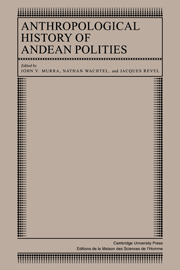Book contents
- Frontmatter
- Contents
- List of contributors
- Preface
- Introduction
- Part I Ecology and society
- Part II The ethnic group and the state
- Part III Systems of classification
- Part IV Symbolic representations and practices
- Part V From ethnic polities to communities
- 15 Men of the water: the Uru problem (sixteenth and seventeenth centuries)
- 16 The ethnic groups in the valleys of Larecaja: from descent to residence
- 17 The Andean community today
- Bibliography of published source
- Index
17 - The Andean community today
Published online by Cambridge University Press: 05 October 2010
- Frontmatter
- Contents
- List of contributors
- Preface
- Introduction
- Part I Ecology and society
- Part II The ethnic group and the state
- Part III Systems of classification
- Part IV Symbolic representations and practices
- Part V From ethnic polities to communities
- 15 Men of the water: the Uru problem (sixteenth and seventeenth centuries)
- 16 The ethnic groups in the valleys of Larecaja: from descent to residence
- 17 The Andean community today
- Bibliography of published source
- Index
Summary
The foregoing studies have shown how the colonial period led to the gradual erosion of the Andean ethnic groups. This long process of fragmentation culminates in the basic social units being reduced to a “community.” This, at any rate, is the term used in the anthropological literature to define the present-day village societies. It refers to a wide range of different contexts, but the disadvantage is that by isolating the reality of the Andes from its historical context, it fails to do it justice.
This reductionist category is administrative in origin: In the 1570s, Viceroy Toledo had ordered the Indians to be regrouped in villages or reducciones and had allocated collective fields (tierras del comúri) to them. This reorganization of their social and economic life was largely modeled on the comunidades of Castille, Estremadura, and the Kingdom of Leon, some of which are still functioning. The terms común and comunero were very quickly assimilated into the Indian lexicon, the former becoming a synonym of ayllu, in the Andes the latter of “Indian.” After independence and Simón Bolívar, the comunidades were dissolved by decree, allegedly so as to eliminate discrimination against the Indians; their fields could thereby fall pray to the latifundia. It was only after 1920 that the Peruvian constitution came to revive a colonial policy of defending the collective fields, providing the comunidades indígenas with a juridical status.
- Type
- Chapter
- Information
- Anthropological History of Andean Polities , pp. 342 - 358Publisher: Cambridge University PressPrint publication year: 1986
- 4
- Cited by



